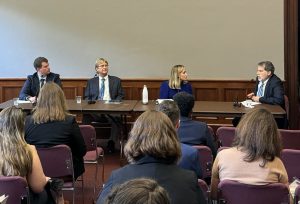California preparing to implement national eDNA monitoring strategy

SCCWRP and its partners are preparing to lead California in implementing a White House-led national science strategy being released in June that is intended to bring standardization and consistency to how environmental DNA (eDNA) methods get incorporated into aquatic monitoring programs nationwide.
The national eDNA strategy, expected to be unveiled during the 3rd National Workshop on Marine eDNA that runs June 3-5, 2024 in Washington, D.C., will establish a unified vision and roadmap for how multiple federal, state and local environmental agencies work together to expeditiously transition eDNA-based monitoring methods from pilot-scale studies to broadscale adoption by the end-user management community. The national strategy was developed by the White House Office of Science and Technology Policy.
eDNA-based monitoring uses the DNA that organisms shed into their environment – known as environmental DNA – to monitor a broad range of organisms, often with greater speed, accuracy, and precision than traditional monitoring methods that rely on manual observation of organisms.
Over the past decade, environmental agencies across the nation have been working largely in siloes to develop their eDNA sampling, processing and analytical protocols, which has impeded efforts to standardize these methods across agencies – and even within individual agencies. Agencies also have not been coordinated in their efforts to efficiently close knowledge gaps that pose key barriers to more routine management use of eDNA methods.
In recent years, SCCWRP and its partners have emerged as leaders in helping to unite and coordinate California’s eDNA research and monitoring community – an effort that has helped lay the groundwork for California to expeditiously implement the forthcoming national eDNA strategy in coordination with researchers and management agencies nationwide.
Key eDNA investments that California has made include standardizing eDNA methods statewide, incorporating eDNA-based methods into multiple California monitoring initiatives, articulating and reaching consensus on where challenges and opportunities lie, and closing knowledge gaps. California’s specific accomplishments include:
- Molecular Methods Workgroup: The California Water Quality Monitoring Council’s Molecular Methods Workgroup, led by SCCWRP’s Dr. Susanna Theroux, has developed standardized methods for sampling and reporting, and an educational webinar series to increase eDNA literacy. The group also has helped facilitate collaborations with the California Surface Water Ambient Monitoring Program (SWAMP) eDNA Metabarcoding Monitoring and Analysis Project (SeMMAP) and the UN Ocean Decade project West Coast Ocean Biomolecular Observing Network (WC-OBON).
- Incorporation of eDNA methods into monitoring programs: SCCWRP and its partners have developed eDNA monitoring capacity for multiple long-term monitoring programs, including the statewide Estuary Marine Protected Areas (EMPA) Monitoring Program and the Southern California Bight Regional Monitoring Program. These programs have served as a proof-of-concept to test and compare eDNA methods to traditional monitoring approaches, as well as familiarize end users with eDNA-based methods.
- Research to close knowledge gaps: SCCWRP and its partners have been working to fill multiple knowledge gaps, including an ongoing three-year project to measure how eDNA degrades in ocean water under different environmental conditions until it’s no longer detectable. Researchers also are expanding global DNA reference libraries to increase the types of organisms that can be identified by their genetic signatures. Most recently, the California Ocean Protection Council announced plans to significantly expand DNA reference information for intertidal species, which are among the organisms most at risk as water temperatures and sea levels increase.
In preparation for releasing the national strategy in June, the eDNA strategy writing team is planning to issue written responses to all public comments that were submitted through a federal Request for Information (RFI) process last year. Among these public comments is a summary of an all-day CTAG workshop that identified constraints and challenges that SCCWRP’s member agencies are facing incorporating eDNA-based methods into monitoring programs.
For more information, contact Dr. Susanna Theroux.
More news related to: Bioassessment, DNA Barcoding, Top News